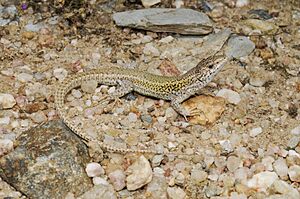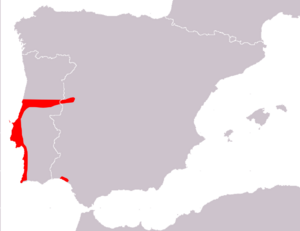Carbonell's wall lizard facts for kids
Quick facts for kids Carbonell's wall lizard |
|
|---|---|
 |
|
| Conservation status | |
| Scientific classification | |
| Genus: |
Podarcis
|
| Species: |
carbonelli
|
| Synonyms | |
|
|
The Carbonell's wall lizard (scientific name: Podarcis carbonelli) is a fascinating type of lizard. It belongs to the Lacertidae family, which includes many quick and agile lizards. You can find this special lizard living in Portugal and Spain.
This lizard can grow up to 20 centimeters (about 8 inches) long, including its tail. It mainly eats small invertebrates like insects, arachnids (like spiders), and snails. Its favorite places to live are warm shrublands and sandy shores. Sadly, losing its natural home is a big problem for its survival.
| Top - 0-9 A B C D E F G H I J K L M N O P Q R S T U V W X Y Z |
What's in a Name?
The scientific name, carbonelli, was chosen to honor "J. Carbonell." She is the wife of Pérez-Mellado, the person who first described this lizard.
Meet the Carbonell's Wall Lizard
Carbonell's wall lizard is a small reptile. Its body, from its nose to where its tail begins, is about 6.5 centimeters (2.5 inches) long. Its tail is usually twice as long as its body! In some places, female lizards are a bit bigger than males.
Most of these lizards have a grey or brown back. But some, especially the males, can be green. Their backs often have many dark spots arranged in rows. The sides of their bodies might also look greenish with dark, net-like patterns. Their bellies are whitish, and they often have small blue spots along the edge of their stomachs.
This lizard is different from other wall lizards in its area. It usually has green sides but not a green back. It looks a lot like the Bocage's wall lizard. However, Bocage's wall lizard usually has clearer markings and a yellow, orange, or pink belly. It also doesn't have green sides or blue scales on its outer belly.
Where They Live and What They Like
Carbonell's wall lizard calls Portugal and Spain home. You can find them in several separate groups. Some live in western and central Portugal. Another group lives in Coto Doñana in southwestern Spain. There's also a special type of this lizard on the Berlenga Islands off the coast of Portugal.
These lizards love Mediterranean weather with cool to warm summers. They do very well on the Atlantic coast, living in sand dunes with very little plants. But the groups living inland in the western mountains, up to 1,200 meters (about 3,900 feet) high, seem to be shrinking fast. This might be because of global warming.
Different Types of Carbonell's Wall Lizard
There are two main types, or subspecies, of Carbonell's wall lizard:
- Podarcis carbonelli carbonelli: This is the most common type. It lives on the main Iberian landmass.
- Podarcis carbonelli berlengensis: This type is only found on the Berlenga Islands. It's a cool example of island gigantism, which means animals on islands sometimes grow larger than their relatives on the mainland. Besides being bigger, P. c. berlengensis also has slightly different colors.
How They Behave
You can often spot Carbonell's wall lizards on dry banks. Sometimes, there are many of them in one place! They like to hide in cracks in the ground or among tree roots to stay safe.
What's on the Menu?
P. carbonelli mainly eats arthropods, which are creatures like insects and spiders. But on the Berlenga Islands, they also enjoy eating snails.
Having Babies
Carbonell's wall lizards lay eggs. This means they are oviparous. In central Portugal, females usually lay one group of two eggs each year. But on the Berlengas Islands, they can lay several groups of up to four eggs! These eggs take about ten to fifteen weeks to hatch.
Why They Need Our Help
Carbonell's wall lizard lives in many separate groups. Its total living area is less than 5,000 square kilometers (about 1,900 square miles). They live in oak woodlands and shrublands. Even though some groups live in protected areas, others are losing their homes because of human activities.
While they are common in some good habitats, their overall population is thought to be going down. Because of this, the International Union for Conservation of Nature has listed them as an "endangered species." This means they are at a high risk of disappearing forever if we don't help protect them and their homes.
See also
- The Italian wall lizard, another lizard species that is related to Carbonell's wall lizard.



